Decibel Festival: Things We Loved, Things We Liked, and Things That Needed Work
Last week, XLR8R hopped on a plane to Seattle to check out the city’s annual […]
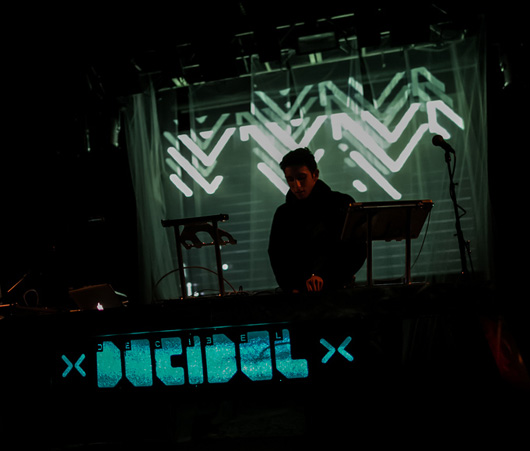
Decibel Festival: Things We Loved, Things We Liked, and Things That Needed Work
Last week, XLR8R hopped on a plane to Seattle to check out the city’s annual […]

Last week, XLR8R hopped on a plane to Seattle to check out the city’s annual Decibel Festival. Admittedly, we were pretty excited to partake in the festivities; after all, we did just dedicate an entire series of content to the long-running festival. With nearly 200 artists on the bill, there was a lot of to see over the five days and nights of Decibel, and it wasn’t all just DJs playing banging beats in dark nightclubs—although, yes, there was plenty of that. However, there were also concerts, A/V showcases, boat parties, after-hours events, panel discussions, gear workshops, and more. Without question, the 2012 edition of Decibel was the festival’s most ambitious to date; that said, there were times that the festival’s organization cleary chafed under the weight of that ambition. Nonetheless, it’s hard to fault the Decibel team for reaching a bit beyond its grasp, particularly when so much of the festival was innovative and decidedly unfocused on the mainstream (even the electronic mainstream). More importantly, most of the week’s events—the nighttime showcases in particular—were downright fun.
LOVED: Andy Stott
When one is at a multi-day music festival like Decibel, a lot of small talk is involved. As the days wear on, attendees end up running into familiar faces—both old friends and new ones made during the course of the festival—and inevitably, the conversation shifts to something along the lines of, “What did you like this week?” For us, the answer was simple: Andy Stott. The UK producer performed live on Thursday night at the Modern Love showcase, and flat-out floored the dark basement confines of Melrose Market Studios. Positioned atop an impressive bill that also featured Demdike Stare—who was also excellent—Stott piloted an hour-long journey that began with murky dub techno, worked its way through chugging rhythmic exercises, and peaked with his use of what sounded like classic hardcore and rave drum patterns that had been slowed to a more manageable tempo���without sacrificing any of their euphoric impact. Stott and the Modern Love crew aren’t known for making music that’s particularly “fun,” but they kept the dancefloor buzzing on this night, even as logistical problems meant that the entire affair was running nearly an hour behind schedule. Nonetheless, the show was a clear festival highlight, and Andy Stott led the charge.
Demdike Stare at Modern Love showcase (by Vitamin Dee)
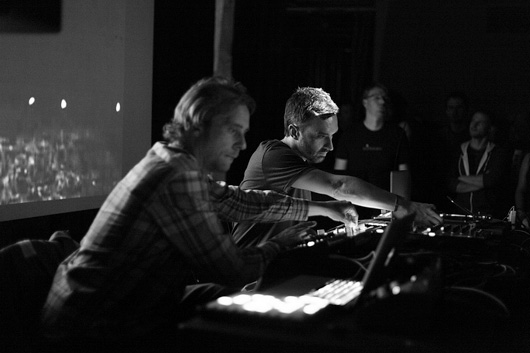
LIKED: FaltyDL
Brooklyn beatmaker FaltyDL headlined the Global Selektors 1 showcase on the festival’s first night, and pieced together a set of melody-infused, garage-leaning sounds that was just about perfect. (Maybe even a little too perfect, as he DJed with Ableton; as such, it lacked some of the rough-around-the-edges charm and, yes, the element of danger that often colors more traditional, or even Serato-based DJ sets.) Performing for an enthusiastic crowd at the city’s seasoned Re-Bar, FaltyDL pulled out bits of house, techno, and garage, all of which leaned heavily on organic sounds and off-kilter drum patterns. The tunes were excellent, but even more impressive was his ability to maintain the room’s vibe without delving into obvious cuts or even upping the music’s energy level significantly. One might say FaltyDL was playing a “mature” set, but that’s not meant as a condescending remark. Building a dancefloor without opening the throttle all the way is no simple task, yet he did exactly that.
NEEDED WORK: The Do-Over
Make no mistake, The Do-Over is a great party. The LA-based event is practically an institution at this point, effectively combining sun-soaked afternoons with various strains of DJ culture. In recent years, The Do-Over has increasingly taken its act on the road, and 2012 marked its first stop at Decibel. Unfortunately, the afternoon show was a complete bummer. Situated in the grass outside Broadway Performance Hall (which served as the festival’s de facto headquarters throughout the week), the party had a decidedly scuzzy vibe, one that wasn’t helped by the pastiche of gutter punks, past-their-prime ravers, and transients who seemed to make up the bulk of the crowd. Normally, being at The Do-Over is like attending a great backyard BBQ; there’s an intimate feel, great tunes are blasting, people are dancing, and those that aren’t on the floor are usually vibing with a drink in their hand. The Decibel edition didn’t come close to recreating that. For much of the afternoon, the dancefloor was nearly empty, populated only by a few weirdos in oversized cargo pants and stupid hats. There was a bar, but alcohol was limited to an odd little corral situated to the side of the proceedings, meaning that a huge chunk of the crowd was completely separated from the festivities. It also didn’t help that some of the music was atrocious, especially the cuts served up by Seattle’s own Supreme La Rock. His dated brand of turntablism-flavored DJing did not go down well with the Decibel crowd; granted, a segue of Toto’s “Africa” into the Cheers theme isn’t likely to get anyone excited in 2012, nor is a medley of “Rockin’ Robin” into the themes for The Jeffersons and The Golden Girls. (Yes, he really played these tunes.) In truth, having The Do-Over at Decibel is a great idea. It’s just that the execution, artist selection, and location simply were not up to par.
LOVED: John Talabot
We first fell in love with John Talabot‘s live set at this year’s Sónar festival in his hometown of Barcelona. Several months later, he’s now in the midst of his first-ever US tour, and the Spanish producer made a key stop at Decibel, headining the festival’s official closing party. As he did at Sónar, Talabot—with plenty of help from live collaborator Pional—served up a set of rousing electronic pop, his sounds colored in by bits of Balearic euphoria, pitched-down vocal hooks, and plenty of nods to vintage house and techno. After five days and nights of revelry, those in attendance wouldn’t have been blamed for feeling lethargic, but the crowd was actually ecstatic, even when Talabot played a few new cuts. Following this short string of solo dates, he will be hopping on tour with The xx; this show at Decibel proved that he’s clearly up to the task.
NEEDED WORK: XLR8R showcase
“What happened to Actress?” Over the course of the week, we heard some approximation of this question literally hundreds of times. Needless to say, it was a big disappointment that the UK innovator didn’t manage to get his visa sorted on time and was forced to cancel his headlining performance at Decibel. He was clearly one of the acts that people really wanted to see, and although Nosaj Thing was a more than capable replacement, Friday night’s XLR8R showcase was facing an uphill battle before it even started. It didn’t help matters that the show’s sound crew seemed woefully underprepared, to say the least. I was scheduled to spin an opening set, but when I arrived at the Baltic Room that night and inquired about the DJ set-up, the engineer literally had no idea what I was talking about. (Eventually, a makeshift DJ rig was assembled, although I ended up facing a wall—instead of the crowd—while playing.) On top of that, complicated live set-ups for both Gulls and Teengirl Fantasy helped ensure that the schedule would be running way behind all night. The problems continued from there. The Baltic Room was full, but the late start and delayed set times made everyone antsy. Gulls’ dubby creations lulled the crowd into a sort of malaise. An especially long changeover between Gulls’ and Teengirl Fantasy’s sets—itself marred by a failed attempt to have me DJ again between the acts—didn’t help matters. By the time Nosaj Thing wrapped up around 1:30 a.m., the crowd seemed more relieved than overjoyed. In short, it wasn’t the best thing XLR8R has lent its name to.
LOVED: Teengirl Fantasy
Despite the technical and logistical issues with the XLR8R showcase, Teengirl Fantasy was excellent. Members Nick Weiss and Logan Takahashi have really honed the project into a well-oiled machine in the live setting, and their unique brand of leftfield house sounded great. Commanding a fleet of gear and delivering with a real performative flair, the duo showed why DIY, analog-driven electronic music doesn’t have to be a clumsy affair. Teengirl Fantasy is one of those outfits that just keeps growing and getting better, and witnessing the latest stage of the group’s evolution was a genuine pleasure.
xxxy at Surefire showcase (by Angela Dawn)
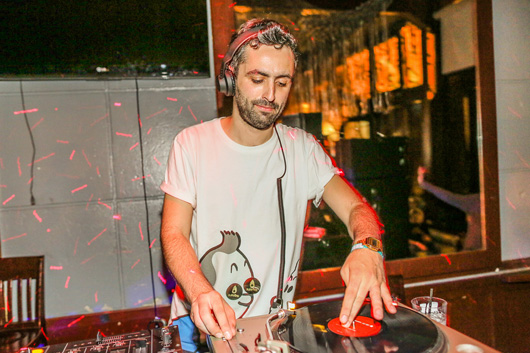
LIKED: xxxy
XLR8R has been touting the DJ prowess of xxxy for some time now, and his appearances at Decibel did nothing to convince us that these endorsements were not justified. Quite simply, the man is an excellent DJ, one who can skillfully move the dancefloor with a potent mix of classic house and garage along with a smattering of new UK (and UK-influenced) tunes. He performed three times over the course of the week, the first at the Boiler Room, where he delivered the standout set despite sharing the bill with quality DJs like DVS1, Appleblim, and Pezzner. Even more enjoyable was his set that evening at the Baltic Room, where he headlined the Surefire showcase and repeatedly elicited throngs of cheers from a crowd that was perhaps a bit weary following Objekt’s hard techno workout and Kuedo’s bombastic, hip-hop flavored assault. He rounded out the week with a late-night stop at the Icee Hot After Hours, and although the crowd was starting to dwindle by the time he got up behind the decks, the music wasn’t lacking in quality. (Disclaimer: Icee Hot is a label/party that I have a hand in running.)
NEEDED WORK: DB After Hours
Throughout the week, Decibel lined up a series of late-night afterparties, with the intention of allowing festival attendees to keep partying into the wee hours. It was a wonderful idea in theory, as most people attending a large-scale electronic-music festival, especially those who traveled to Seattle to attend, were not looking to shut their evenings down at 1:30 or 2 a.m. Unfortunately though, many of the afterparties were a bust. First and foremost, while it’s nice to have parties with top-notch DJs running all night long, it’s very difficult to keep people on the dancefloor without alcohol unless the nights are absolutely slamming. Obviously, it would be unreasonable to expect Decibel to illegally provide alcohol, but organizers should have everything apart from that to make these parties both desirable and easy to attend. On the whole, that didn’t happen, a phenomenon that wasn’t helped by the fact that entrance to the After Hours often required the purchase of a separate ticket, even for those who had already shelled out a lot of money for a festival badge. Regardless of who was playing, when it was 3 a.m. and one was faced with the choice of going home or paying $20 or more to go inside a party with no booze, many folks went with the first option. Another factor contributing to the poor turnout was that fact that there was usually a gap between when the showcases ended and the After Hours began. Even when showcases and afterparties were happening at the same venue, the entire club would be cleared out before the late-night festivities began. As such, even those attendees who were willing to stay out late and pay for a ticket were being forced to wait on the street for 30, or even 60 minutes before they could come inside once again.
If these afterparties are going to continue happening in the years ahead, they need to start immediately upon the completion of the showcases, or even a little bit before. Furthermore, the entrance needs to be free for people with festival passes, or attendees should at least be able to buy a “VIP” badge that includes entrance to these parties.
xxxy at the Boiler Room (by Nic Launceford)
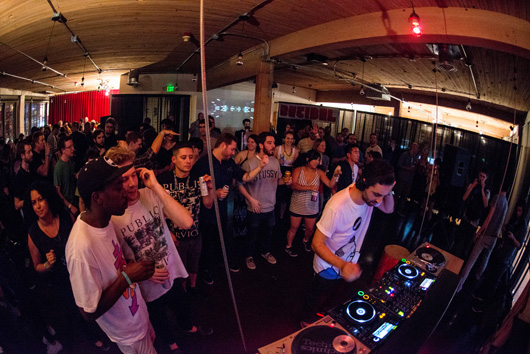
LIKED: Boiler Room
The scheduling of two Boiler Room sessions to the Decibel proceedings was a last-minute addition to the line-up, but it was certainly a savvy move on the part of the festival organizers. Happening from 6 to 9 p.m., hours when there was a definite a gap in the Decibel schedule, both evenings were packed with revelers. Taking place in a gorgeous Capitol Hill loft space, those lucky enough to track down an invite downed free drinks, mingled with friends, and filled the dancefloor as DJs and live acts rolled out tunes not just for those at the party, but for people watching the whole thing broadcast online. As mentioned before, xxxy was a definite standout on the first night, while we thought Ghosts on Tape stole the show on Friday evening with his banging house and techno selections, which provided a welcome change of pace from that night’s more hip-hop- and bass-flavored line-up. (Disclaimer: Ghosts on Tape is one of my partners in Icee Hot. That said, he really was excellent.)
LOVED: Hotflush Showcase
Bass-music aficionados had Saturday night’s Hotflush showcase at the Baltic Room circled on their calendar well before Decibel began, and the line-up of Braille, George FitzGerald, and Sepalcure did not disappoint. Braille began the evening with a relatively subdued set, overcoming a few Ableton glitches before serving up an array of moody, garage- and house-infused selections. FitzGerald was up next and promptly amped the energy level. His recent releases have displayed an increasing tendency toward dancefloor-oriented rhythms, and his DJ stylings have followed suit. While his set had plenty of melodic flourishes, a heavy kick was present throughout, as were frequent nods to classic house and garage tropes. The crowd loved it, repeatedly shouting its approval as FitzGerald moved from one tune to the next. Capping the evening was Sepalcure, which found Braille back on stage with partner Machinedrum. The duo performed live, manipulating their textured sounds with MIDI controllers, cycling through different tempos, and unfurling one unique drum pattern after another. Both men seemed extremely confident on stage, which allowed them to get a bit playful as the set wore on; Machinedrum even hopped on the mic and sang live in place of a few vocal samples. When the lights came on at 1:30 a.m., the room was full of smiles, and it was clear that most people in attendance had had a very good night.
LIKED: Objekt
In perhaps one of the biggest scheduling quirks of the festival, Berlin-based producer Objekt took the stage at 9:30pm on Thursday night, opening up the Surefire showcase at the Baltic Room. Given his predilection for hard, banging techno, we weren’t sure exactly what to expect, as it wouldn’t have been inappropriate for him to change things up and put on some mellow offerings in the spirit of warming up the room. It’s possible that he followed that idea at the beginning of his set, but by the time we arrived around 10 p.m., Objekt was doing was he does best: playing dark, slamming techno. It could have been a disaster, but the rapidly swelling crowd seemed to be more than happy to hear the man doing his thing, and doing it well. Although Objekt is relatively young, there was a real old-school sensibility to his set, partially due to his use of vinyl, but also because he eschewed trendy cuts and stayed true to his singular vision. This was music for late nights, dark corners, and abandoned warehouses. It was big, it kowtowed to no one, and it sounded great, even though the clock hadn’t yet struck 11.
Carl Craig at Motor City Masters showcase (by Eva Blue)
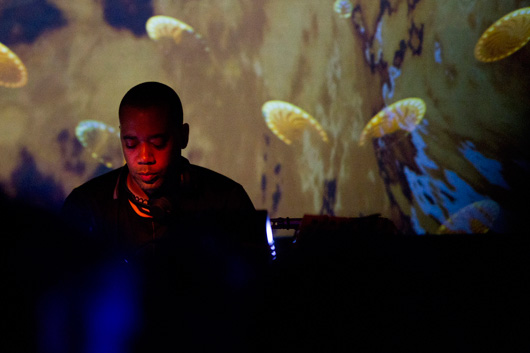
LIKED: Seattle
Decibel is not one of those festivals that happens in a giant field with multiple stages and tens of thousands of attendees. It’s spread over several nights, and takes place in numerous clubs scattered around Seattle, with multiple showcases happening simultaneously. As such, attending Decibel required a lot of actual interaction with city, or at least its downtown and Capitol Hill neighborhoods. Smartly, most of the venues were within walking distance of one another. The city was relatively easy to navigate, not to mention downright pleasant to be in. The weather was perfect, the streets were clean, greenery was everywhere, and people were friendly. Seattle also proved to be impressive on the food front; from late-night hot dogs to typical West Coast meals built with locally grown ingredients, attendees’ culinary appetites were well catered to. Honestly, Seattle came across as a safe, pleasant, and inherently livable city. Its combination of a laid-back spirit with an open-minded perspective is hard to come by, and undoubtedly helped create an atmosphere where an event like Decibel could not only exist, but thrive.
NEEDED WORK: ’90s state of mind
For all the great things about Seattle, being in city occasionally felt like crawling into a time machine and heading back to the ’90s. As liberal and open-minded as the place came across, it was sometimes hard to shake the notion that things were stuck in an odd sort of time warp. (Anyone who’s seen the PortlandiaDream of the ’90s sketch will likely find that Seattle suffers from a similar affliction.) Whether it was grunge-rock leftovers wandering the street or aging tech-ravers still clinging to their oversized cargo pants, tribal tattoos, and goofy utility belts, the city didn’t always convey a particularly forward outlook or aesthetic. As big as electronic music is in Seattle, the city is not Berlin. It’s not London. It’s not even New York or San Francisco. (Okay, maybe it’s a little San Francisco with all the hippie-flavored, Burning Man-esque nonsense going on.) In terms of Decibel, this didn’t mean that the festival wasn’t fun. It just didn’t feel especially “cool,” and there were ample opportunities for cynical out of towners (ourselves included) to make cheap jokes about people’s boot-cut jeans or misguided dreadlocks. That said, given Seattle’s pleasant nature and the general sense of friendliness that permeated the festival, maybe the joke was on us after all.
Q (by Angela Dawn)
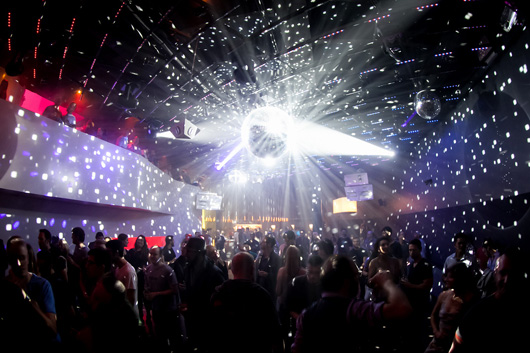
LIKED: Sound quality
While the sound quality did vary from venue to venue, it was clear that Decibel organizers made an effort to ensure that festival events at least met a minimum standard across the board. Throughout the week, people were raving about the booming sound at Neumos—although some actually did find it too intense—and the sound system at the newly opened Q was impeccable. Even at older spots like the Baltic Room and Re-Bar, the sound was never bad. In a perfect world, sound quality would never be an issue at festivals, but it’s an area where organizers often choose to skimp, particularly those who don’t understand its importance in relation to electronic music. It’s clear that Decibel organizers are fans of the music first, which is why they acted accordingly and did their best to protect everyone’s eardrums.
Carl Craig at DB Conference (by Eva Blue)
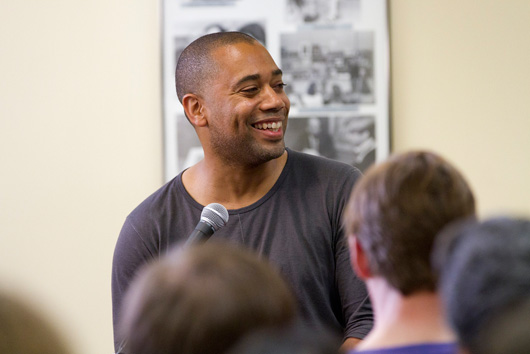
NEEDED WORK: Organization
Without question, operating a festival in the vein of Decibel is not a lucrative venture. That’s likely why much of the staff consists of volunteers, and although everyone we met was friendly and did their best to be helpful, in the end, they were still volunteers, which meant that a lot of details fell through the cracks. Talking to the staff throughout the week, it was clear that everyone had a lot on their plate, and it occasionally seemed like some people shirked their responsibilities under the weight of that pressure. After all, they were volunteers, so nobody faced severe repercussions when things went awry. For instance, the DB Conference—a series of workshops and panel discussions throughout the week—was plagued by cancellations and last-minute changes. The Decibel mobile app was littered with incorrect information and also just failed to list several events. The festival website was a bit clunky and sometimes listed conflicting or incorrect information. Showcases ran behind. Artist riders that were submitted multiple times never found their way to sound engineers. For those performing, getting simple questions answered about where to be and who to talk to was often a laborious process. The list goes on and on.
In fairness, many of these issues are present at all festivals, even ones where the entire staff is getting paid. It’s just a matter of degree in terms of how much these issues affect the festival experience. For Decibel, the effect wasn’t disastrous, but it could certainly be felt, especially when it came to behind-the-scenes details and the festival’s extracurricular events apart from the showcases.
LIKED: Curation
Although things at Decibel didn’t always run as smoothly as they should have, the festival nonetheless proved itself to be something worth celebrating. When it comes to electronic music in the US, prospects remain relatively grim. Given the explosion of grossly commercial “EDM” festivals in the past year or two, it would have been easy for Decibel to follow a similarly vapid—albeit financially secure—path. Yet organizers held fast to their vision, and curated a five-day event that was remarkably devoid of big-name headliners. Instead, they found a way to bring in cutting-edge artists from across the electronic spectrum—honestly, there were so many great acts we didn’t even get a chance to see perform, including Shlohmo (pictured at top), Balam Acab, Tycho, Matthew Dear, Dixon, Peter Van Hoesen, Octave One, and others too numerous to list—and made it work.
On paper, building showcases at a US festival around avant-garde labels like Raster-Noton and Modern Love seems like insanity. Similarly, Carl Craig may be a techno legend and an incredibly important artist, but he’s not exactly slam-dunk headliner material for a large American festival. Even Decibel’s most “name” acts—Orbital, DJ Shadow, Erykah Badu—operate well outside the musical mainstream. Yet somehow, it all came together, and that was a wonderful thing to witness.
Decibel devotes itself to things that are new and weird. It celebrates electronic music’s lineage without simply being an exercise in nostalgia. Simultaneously, it provides a platform for dozens for artists that even the headiest of electronic-music aficionados are likely unfamiliar with. Furthermore, it’s not just a series of parties. There’s a desire to educate and grow the scene, and a real sense that organizers are attempting to give something back to a community that has clearly enriched their own lives. None of this is easy, yet they keep on doing it, which is why XLR8R has been, and will continue to be, an ardent Decibel supporter.

